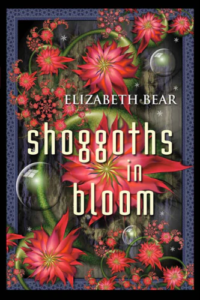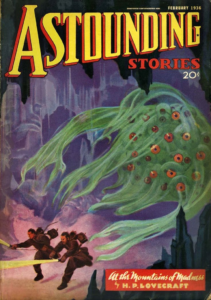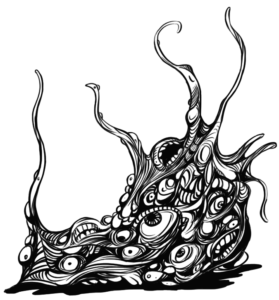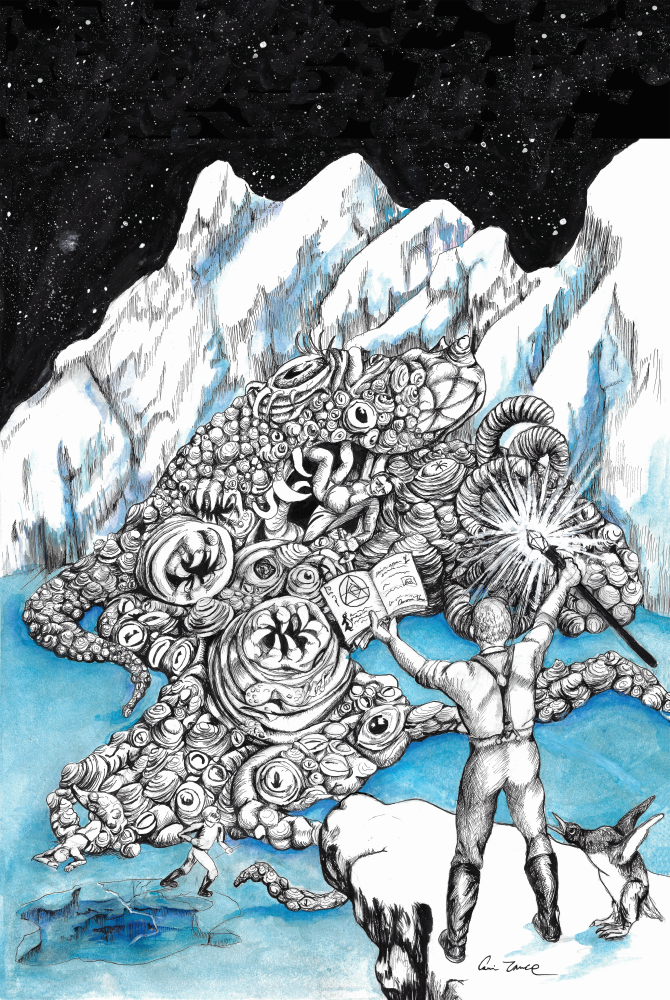… the nightmare plastic column of foetid black iridescence oozed tightly onward through its fifteen-foot sinus; gathering unholy speed and driving before it a spiral, re-thickening cloud of the pallid abyss-vapour. It was a terrible, indescribable thing vaster than any subway train—a shapeless congeries of protoplasmic bubbles, faintly self-luminous, and with myriads of temporary eyes forming and unforming as pustules of greenish light all over the tunnel-filling front that bore down upon us, crushing the frantic penguins and slithering over the glistening floor that it and its kind had swept so evilly free of all litter. Still came that eldritch, mocking cry—“Tekeli-li! Tekeli-li!“
— H.P.Lovecraft , “At the Mountains of Madness”
Shoggoth. The sight of one strikes fear into poor Danforth and William Dyer of the Miskatonic University expedition in At the Mountains of Madness. The mere mention of them can drive any gamer to madness as well.
Such creatures abound throughout our games. While Chaosium’s Call of Cthulhu envisions our article’s focus directly, D&D has its gibbering mouthers and chaos beasts (not to mention the various slimes, jellies, puddings, and oozes!), and Warhammer Fantasy has its various chaos spawn. There are various Shoggoth incarnations for Pathfinder, and retro clones. Given that the early creators of RPGs were prodigious devourers of fantasy and science fiction in all forms, no doubt they could’ve also taken inspiration from such offerings as 1958’s cult classic The Blob, the story of a mysterious thing that falls from the sky and begins devouring everything it can find.
In Lovecraft’s story, the shoggoths are the creatures that ultimately destroy the Elder Things, and can grow to immense size and assume nearly any shape they need to accomplish a goal. They are, in a mechanistic word, all about options. But, if you peruse the various gaming versions of the shoggoth, they are anything but about options. And so, since DCC is all about options as well, we set out to build a set of tables that help you build the best shoggoth you can—whether it is a small, young shoggoth, or a monstrosity that is tens of thousands of years old—you can build the whole range of shoggoths in this article.
Monsters are often the purview of just the judge, and while judges need monsters to keep their stories fresh and fun, we didn’t want to leave the players feeling less than loved. So—we decided to continue fleshing out the Cthulhu related spells, and create a specific find familiar spell that allows the wizard to bond to smaller shoggoths and keep them around as bonded companions.

Find familiar, shoggoth edition (tentative)

Shoggoths in Bloom, by Elizabeth Bear
We also spent quite a bit of time reading other literary takes on shoggoths, and seeing where those led us as we explored this classic monster. Such short stories as Shoggoths in Bloom, by Elizabeth Bear, and various anthologies put together by folks who really love the Cthulhu mythos and how it has expanded beyond Lovecraft, provided us with inspiration. We plan to share that literature with you in the form of another Appendix N supplement at the end of the shoggoth article (as we did with our Cthulhu patron article in issue #1, and room permitting).
In the end, shoggoths return to that word: options. Our article gives you a LOT of options so that every shoggoth is different and unique.
The full DCC rules for using shoggoths as monsters and familiars can be found in issue #2 of Tales from the Smoking Wyrm, available now from Goodman Games and DriveThruRPG !



